A Taste of the Trace
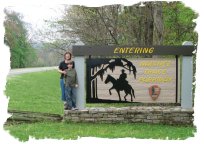 From Nashville we decided to go straight and push on towards Little Rock. However, it seemed a shame not to see any of the Natchez Trace, which starts about a ½ hour southwest of downtown Nashville. So a compromise was in order, and we took a side trip, driving down the first 50-60 miles of the parkway. It made for a long day (we didn’t pull into the campground in Little Rock until after dark), but well worth the detour.
From Nashville we decided to go straight and push on towards Little Rock. However, it seemed a shame not to see any of the Natchez Trace, which starts about a ½ hour southwest of downtown Nashville. So a compromise was in order, and we took a side trip, driving down the first 50-60 miles of the parkway. It made for a long day (we didn’t pull into the campground in Little Rock until after dark), but well worth the detour.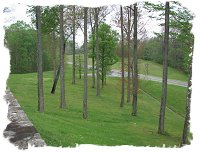 The Parkway is simply beautiful. Groomed in a similar manner to the Blue Ridge Parkway, the northern end gently sweeps thru rolling hills, surrounded by forests and well maintained farmland. On a drive down the entire length of the Blue Ridge Parkway several years ago, Denise and I noticed the encroachment of civilization along the edges of the parkway. It didn’t seem near as bad on the Natchez Trace, although perhaps we simply didn’t travel enough of the parkway to experience it.
The Parkway is simply beautiful. Groomed in a similar manner to the Blue Ridge Parkway, the northern end gently sweeps thru rolling hills, surrounded by forests and well maintained farmland. On a drive down the entire length of the Blue Ridge Parkway several years ago, Denise and I noticed the encroachment of civilization along the edges of the parkway. It didn’t seem near as bad on the Natchez Trace, although perhaps we simply didn’t travel enough of the parkway to experience it.Several of our friends in Bryson City have biked the Trace, and it is easy to see the attraction. We spoke briefly with one older gentleman who was biking, with his wife pulling a small pop-up trailer in support. He had 40 miles under his belt by early afternoon, and had worked up a good sweat! Biking the parkway is something we could consider doing sometime in the future. According to our friend Ellen Kilganon, the best time to do it is in the fall – summer is too hot, spring is too snaky!
The Natchez Trace began as a traditional route used by Native Americans and early European explorers. In 1801, the U.S. Army began improving the trail for use as a postal and trading route. Treaties were signed with the Chickasaw and Choctaw tribes whose lands the Trace passed thru. By 1809, the trail was fully navigable by wagon. The Trace provided the only practical land trade route from the north to the ports of Louisiana. The Trace also provided a route home for boatman who had floated down the Mississippi or who took a one way passage downstream.
We saw an uncommon amount of wild turkey along the route – probably 20-30 over the couple of hours we were there. The sounds of birds singing was particularly striking when we stopped and got out of the car.
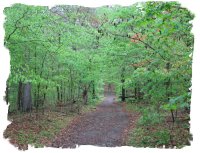 Portions of the original Trace still exist, and have been preserved by the Park Service. We stopped and walked along a couple of these segments. It was easy to imagine walking back home after a season of floating down the river on a raft full of trade goods, hoping you could make it back safely without meeting up with bandits on the highway.
Portions of the original Trace still exist, and have been preserved by the Park Service. We stopped and walked along a couple of these segments. It was easy to imagine walking back home after a season of floating down the river on a raft full of trade goods, hoping you could make it back safely without meeting up with bandits on the highway.We tried to find a ranger station where we could get Vance’s National Park Passport book stamped. Denise, looking in the Natchez Trace pamphlet we picked up, read that Meriwether Lewis was buried at the next stop. “The Meriwether Lewis, of Lewis & Clark fame”, I blurted? It took me a minute to remember my history, that Lewis either committed suicide, or was murdered (somehow he managed to shoot himself twice with the same muzzle loader pistol, a somewhat difficult task….) along the Natchez Trace not long after completing his famous Expedition.
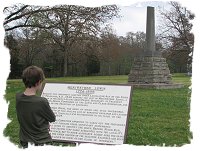 Sure enough, there was a small museum commemorating Lewis. His grave site, in the middle of a pioneer cemetery, has a fairly impressive monument erected in his honor. It was a good 'out of the blue' history lesson for Vance, who had previously bumped into Lewis & Clark several years ago when we visited Astoria, Oregon, the site of their winter encampment at the Pacific Ocean.
Sure enough, there was a small museum commemorating Lewis. His grave site, in the middle of a pioneer cemetery, has a fairly impressive monument erected in his honor. It was a good 'out of the blue' history lesson for Vance, who had previously bumped into Lewis & Clark several years ago when we visited Astoria, Oregon, the site of their winter encampment at the Pacific Ocean.After 50 miles or so we reluctantly exited the Parkway and turned back west. It was enough of a taste to leave us wanting more - I can easily see us coming back out and driving (or biking) the entire length. Oh, and the Passport Stamp? Just as we were leaving the Meriwether Lewis area, a ranger drove by – Denise flagged him down, and after a fairly complicated interaction that involved us driving over to a maintenance area, got Vance’s stamp (and a Jr. Ranger badge!)

Vance: Natchez Trace is a very old and famous parkway. It stretches from Nashville, TN, all the way to Mississippi! Meriwether Lewis is buried near the trace. He was the leader of the Lewis and Clark expedition back in the beginning of the 19th century.
Andrew Jackson used the Trace to march his troops to the battle of New Orleans. We saw a lot of turkey there. There was a beautiful water fall in the middle of the Trace.
A BEAUTIFUL PARKWAY THAT’S HUNDREDS OF YEARS OLD.
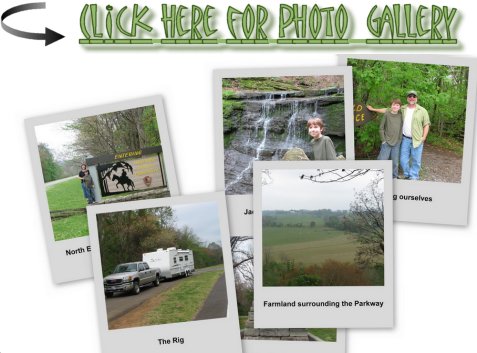
| Previous - The Hermitage | | Home | Index | | Clinton Presidential Library - Next |







<< Home